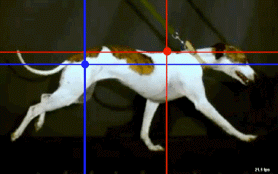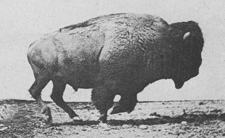1.0 – Limbs as Pendulums
2.0 – Animating Pendulums within Pendulums
3.0 – Structure and Purpose of Limbs
4.0 – Efficiency vs. Exertion
5.0 – X-ray Reference Videos
6.0 – Reference Videos on Quad Anatomy (must watch!)
1.0 – Limbs as Pendulums
Quads are efficient. As soon as a limb is no longer load bearing the quad will use as little energy possible to swing it forward for the next stride. Like a pendulum. If the limb swings at its natural frequency of oscillation it will use the least effort to so.
“Natural frequency is the frequency at which a system tends to oscillate in the absence of any driving or damping force”
– translate arc of foot in a walk, note the over shoot due to the limb acting like a pendulum
In a walk and gallop, the foot swings forward then backwards before hitting the ground like a pendulum. This is so the foot is travelling at the same speed and direction of the ground it is contacting. If it didn’t, the foot would skid, causing stress on the limb.
2.0 Animating Pendulums within Pendulums
– note the range of motion in the joints, this varies greatly from quad to quad
So approaching limbs as pendulums is a good start in quad mechanics. Unfortunately in animating quads we usually manipulate limbs with IK controllers. This can make us lazy to joint rotations. We tend to want to stretch the limb into a position, not fully taking into account the arcs of the joints or the rise and fall of the chest.
– world space rotations intro seen in World Space Animating
Animating limbs in FK gives you greater control of their rotations, especially if you convert your limb to have World Space Rotations like in the above video. Of course the downside of this method is you will have to switch back to IK for the contact frames.
I have found using FK World Space Rotations particularly useful when animating slow motion shots.. or if you are animating in High Frame Rate (HFR) which is less forgiving of pops like 24fps.
In brief, the method I would use for animating FK Limbs would be to work out your contact and release poses and frames first. Then switch to FK in the passing frames.
Your rotation curves will be simple compared to IK translate curves. Even though the limbs rotations are in world space their translations are stills local to body. This means you will be able to copy the curves and easily adjust them for other parts of your animation.
If you don’t have FK limbs in your rig… bummer! 🙂
3.0 – Structure and Purpose of Limbs
The fore limb and hind limbs are designed for different purposes.

In some quads up to 71% of their total weight is supported by their forelimbs, the other 28% by their hind limbs
So, the fore limb supports and balances. The hind limb pushes.
So the front legs steer the quad. The hind legs just follow the front and supply the power. Like a trailer with springs for wheels.
This one of the core reasons why I animate quads initially with the back legs hidden. The forelimbs steer and guides the gait giving the quad personality. Read more in Hide the Legs!? Focus on the Spine
In the above video Richard Williams has some really good notes about animating quads. Particularly approach.
Splitting up quads in components is essential. Not only for understanding their mechanics, but so you can actually animate them. If you do everything at once, you will get lost.
4.0 – Efficiency vs. Exertion
The more you raise the knee and foot during this time can help show how much energy the quad is exerting. This is the same for the spine and chest. The more the limbs push away from the ground the more energy is used.
This works for personality too, puppies although stupid cute are really inefficient and uncoordinated.

It’s this mixture that gives them their cuteness or playfulness in motion. As the grow they become more efficient in their motion and often appear lazy.
– puppies! see how their co-ordination improves over the weeks

Of course over exertion isn’t limited to young quads. Using it in adults can show power and purpose. Look at the reference of police dog Alsatians in training. In particular: when the trainer releases the dog to attack the dummy criminal. This is a great example of over exertion.
Other considerations are if the animal is injured.. something that is so easy to animate.. unfortunately not deliberately. If you too greatly upset the symmetrical nature of gaits this is immediately apparent.
5.0 – X-ray Reference Videos











